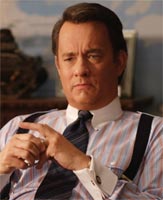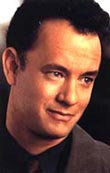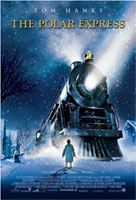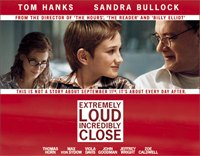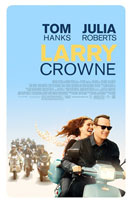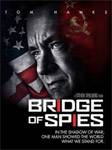Tom Hanks Bridge of Spies
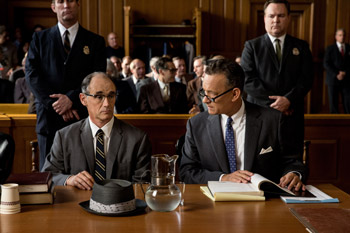
Tom Hanks Bridge of Spies
Cast: Tom Hanks, Amy Ryan, Alan Alda, Mark Rylance, Billy Magnussen
Director: Steven Spielberg
Genre: Drama, Thriller
Synopsis: An American lawyer is recruited by the CIA during the Cold War to help rescue a pilot detained in the Soviet Union.
Bridge of Spies
Release Date: October 22nd, 2015
About the Production
Everyone deserves a defense…every person matters. -James Donovan
The Incredible Story Inspired By True Events
In the 1950s during the early stages of the Cold War, tensions are rife between the U.S. and USSR, so when the FBI arrests Rudolf Abel (Mark Rylance), a Soviet agent living in New York, the fear and paranoia only escalate. Charged with sending coded messages back to Russia, Abel is questioned by the FBI but refuses to cooperate, declining their offer to turn on his country, and is detained in federal prison pending trial.
The government, in need of an independent attorney to take on Abel's defense, approaches James Donovan (Tom Hanks), an insurance lawyer from Brooklyn. But Donovan, a former prosecutor at the Nuremberg trials and highly regarded within the legal community for his profound skills as a negotiator, has little experience with allegations of this magnitude and isn't eager to get involved. Advocating such a deeply unpopular defense would make him a public figure and could subject his family to scrutiny, disdain and even, potentially, danger.
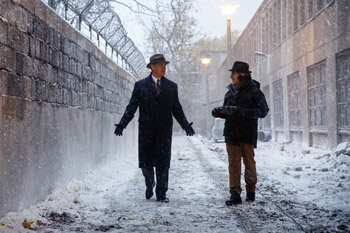 Donovan eventually agrees to represent Abel, as he is committed to the principles of justice and the protection of basic human rights and wants to ensure Abel receives a fair trial regardless of his citizenship. As he prepares his defense strategy, a bond begins to develop between the two men, one built on mutual respect and understanding. Donovan admires Abel's strength and loyalty and mounts an impassioned plea to prevent him from receiving the death penalty, arguing that his actions were those of a good soldier following instructions on his country's behalf.
Donovan eventually agrees to represent Abel, as he is committed to the principles of justice and the protection of basic human rights and wants to ensure Abel receives a fair trial regardless of his citizenship. As he prepares his defense strategy, a bond begins to develop between the two men, one built on mutual respect and understanding. Donovan admires Abel's strength and loyalty and mounts an impassioned plea to prevent him from receiving the death penalty, arguing that his actions were those of a good soldier following instructions on his country's behalf. Sometime later, an American U-2 spy plane is shot down over Soviet airspace while on a reconnaissance mission, and the pilot, Francis Gary Powers (Austin Stowell), is convicted and sentenced to 10 years in prison in Russia. The CIA, while categorically denying any knowledge of the mission, is fearful that Powers may be coerced into revealing classified information. Having witnessed Donovan's impressive skills in the courtroom, CIA operative Hoffman (Scott Shepherd) reaches out to recruit him for a national security mission of great importance, and because of his incredible foresight, Donovan is soon on his way to Berlin to negotiate a prisoner exchange between the U.S. and the Soviet Union, driven by a love for his country, unwavering belief in his convictions and a tremendous amount of courage. Once he arrives however, Donovan learns that an American student named Frederic Pryor (Will Rogers) has been arrested in East Berlin while trying to return to his home in the West, and despite the CIA's direction to focus only on the pilot, he decides to negotiate for the release of both the pilot and the student, as he refuses to leave anyone behind.
We call it the Constitution, And that's what makes us Americans. -James Donovan
Building The Bridge: From Script To Screen
When London-based playwright and television writer Matt Charman stumbled upon a footnote in a biography on John F. Kennedy that referenced an American lawyer whom the President had sent to Cuba to negotiate the release of 1,113 prisoners, his curiosity was piqued. Some quick research yielded a name he did not recognise, that of James Donovan, a successful insurance claims lawyer from Brooklyn. But it was the story of what took place several years earlier which he found most interesting. Donovan had defended a Soviet agent accused of espionage during the Cold War, and while he specialized in insurance law and had not practiced criminal law for some time, was then asked to negotiate one of the most high-profile prisoner exchanges in history.
Charman had little knowledge of the inner-workings of the film industry. Nevertheless, he flew to Hollywood in hopes of convincing a studio to greenlight a film based on Donovan's remarkable true story. While Donovan's role was not well known in the annals of Cold War history, Charman pitched DreamWorks Pictures a gripping tale of an idealistic man navigating the world of national security and subterfuge. The executives at DreamWorks were immediately intrigued.
'When I heard the story, it knocked my socks off," says producer Kristie Macosko Krieger, who was a co-producer on 'Lincoln" and is based at DreamWorks. 'Not many people know the story of James Donovan and what he accomplished during this period of U.S. history, but it sounded like something that was right up Steven Spielberg's alley."
Producer Marc Platt, whose credits include 'Into the Woods," 'Drive" and the upcoming 'The Girl on the Train," was familiar with Donovan's story and was also aware of director Steven Spielberg's interest in the Cold War"and history in general"and felt it was ideally suited for the director's sensibilities. 'As a filmmaker, Steven has studied some great iconic characters and can re-create history in an extraordinarily cinematic way. He's the perfect filmmaker to tell a story like this."
And they were both right. The story was part legal drama, part thriller and part historical epic, and Steven Spielberg was riveted. But it was the character of James Donovan that he found most appealing. The story of a well-respected lawyer living the life of a typical family man in the -50s who took on a dangerous assignment and prevailed through sheer instinct and conviction of principle, had enormous cinematic potential.
'As a youngster growing up in the -50s and -60s, I had a tremendous amount of awareness of what was happening during the Cold War, but I didn't know anything about the exchange of Rudolf Abel for Francis Gary Powers," says Steven Spielberg. 'I knew about Powers because growing up everyone had heard that his U-2 spy plane had been shot down and that he had been put on public display at a very public trial, but the story kind of ended with a spectacular shoot down. I didn't realize that something had happened subsequent to his capture, which was this very backroom exchange, this spy swap between Abel, a Soviet spy, and Powers, the American spy pilot. So there was a lot to this story that really pulled me in."
Charman returned to London to start writing, and within six weeks delivered a thought-provoking, well-crafted script that generated a wonderful feeling of suspense between the multiple stories. Says Steven Spielberg, 'Matt did a good job of connecting the Powers story with the Abel/Donovan story."
It was a clever, and important, juxtaposition because Powers was technically doing the same thing Abel was arrested for, only from the air, and Charman knew that structurally he needed to make all of the different stories speak to one another. Platt agreed, saying, 'Matt did a fantastic job, and once he was finished, we brought his draft to the Coen brothers, who write with a tone which is real yet has a particular edge to it, which was perfect for this story."
The Coen brothers, whose impressive filmography includes titles like 'No Country for Old Men," 'The Big Lebowski" and 'Fargo," immediately dove in, immersing themselves in the language of the period and incorporating Tom Hanks' persona into the character of Donovan, expertly interweaving this remarkable experience in his life into a powerful story that captured the essence of the man.
'Joel and Ethan got us very, very deep into the characters," says Steven Spielberg. 'They really instilled a sense of irony and a little bit of absurd humor, not absurd in the sense that movies can take license and be absurd, but that real life is absurd. They are great observers of real life, as we all know from their great august body of work, and were able to bring that to the story."
One theme woven throughout the texture and framework of the Coen brothers' screenplay which struck a chord with the director was the notion that spies looked like everyone else. He explains, 'It wasn't just shadows and light and spies in a stereotypical way, but it was spies as people that we wouldn't even think twice about, we wouldn't even notice them to begin with, let alone figure out that they're here to do a mission against our national security. Between Matt Charman and Joel and Ethan Coen, I was in the hands of three wonderful storytellers."
Once a finished screenplay was in hand, plans to make the film quickly accelerated. A stellar production team was soon in place, including: two-time Academy Award® winner Janusz Kaminski as director of photography; Oscar® winner Adam Stockhausen as production designer; Kasia Walicka Maimone as costume designer; three-time Academy Award winner Michael Kahn, A.C.E. as editor; and 12-time Oscar nominee Thomas Newman as composer.
'Steven loves authenticity," says Macosko Krieger, 'and we assembled an amazing group of artists to work with him…some of whom we had worked with before, and some who were new to us."
People are scared of this man…he is a threat to all of us. Do you know how people will look at us, the family of a man trying to free a traitor? -Mary Donovan
Bringing The Characters To Life
As a child, the 8mm war movies Steven Spielberg made in his backyard were often set in World War II, a recurring subject in a number of the films he would one day direct"titles ranging from 'Schindler's List," 'Saving Private Ryan" and 'Empire of the Sun" to '1941" and the 'Indiana Jones" films"but until now, none were set in the world of international espionage. 'I love spy movies," says Spielberg. 'I love John le Carré, the James Bond movies, Mad magazine and the infamous -Spy vs. Spy' column that I grew up with, so spying has always been on my mind."
With 'Bridge of Spies," the characters truly are the story, and James Donovan, an insurance lawyer who is lured into the powerful corridors of the FBI and CIA, is the heart of the story. When it came to casting the crucial role, the choice had always been obvious: one of the most iconic actors working today, Tom Hanks.
'There is no one better suited for this role than Tom Hanks," says producer Kristie Macosko Krieger. 'James Donovan is just an ordinary guy…he is like my best friend's dad. He was a guy who did his job and then gets thrown into this incredible international story. That just doesn't happen, but people think of Tom Hanks as everyman, and that's why he is so brilliant as James Donovan."
Tom Hanks and Steven Spielberg share a unique, creative relationship, one that elevates any film with which they're involved. Previous collaborations include 'Saving Private Ryan," 'Catch Me If You Can" and 'The Terminal," as well as the Emmy® and Golden Globe®-winning HBO miniseries based on Stephen Ambrose's book, 'Band of Brothers," and the Emmy-winning 'The Pacific," both of which they produced.
Says Steven Spielberg, 'James Donovan was what you would call a stand-up kind of guy, someone who stands up for what he believes in, which, in his case, is justice for all, regardless of what side of the Iron Curtain you are on. He was only interested in the letter of the law. And Tom's own morality and his own sense of equality and fairness, and the fact that he does such good things in the world by wisely using his celebrity, made him the perfect fit."
'Tom Hanks is a history buff," adds producer Marc Platt. 'You can tell this from some of the great miniseries and films he's produced and acted in. But he also has a particular interest in this period. The Cold War and East/West Berlin politics is something he knows a good deal about."
Based on the caliber of filmmakers already in place, Hanks, who has starred in such diverse films as 'Philadelphia," 'Forrest Gump," 'Cast Away" and 'Toy Story," was inclined to come on board without even reading the script. Once he did, however, he knew it had the potential to become one of the most exciting projects in his distinguished career. 'This subject matter has always fascinated me, because of the area and because of the time," says Hanks. 'I knew that Francis Gary Powers was a U-2 pilot who was shot down by the Soviet Union, that it was a huge international incident and that there was a trade that got him back, but I didn't know any of the details or who James Donovan was."
He continues, 'I love reading history and finding out something brand new"particularly about a subject that I think I'm well versed in"and when that happens, man, it's like winning the lottery."
Tom Hanks was also fascinated by the bond that develops between Donovan and Rudolf Abel. He explains, 'What he developed with Rudolf Abel was, first, a very completely professional relationship as an advocate. He even says, -I am your advocate, my job is to represent you and bring you the best version of American justice that I can surmise, and here's what I think that justice needs to be,' and he was dogged in his pursuit of that. He also developed a great personal relationship with Abel because he felt as though he was fighting for a good guy, both personally and in terms of what he stood for."
To Steven Spielberg, Donovan represents the ideals of a genuinely altruistic person, someone who had the tenacity to put Abel's defense ahead of his own comfort and safety because he truly believed that the law needed to be respected. 'It brought a lot of tension to Donovan's family, the same kind of tension that I imagine my own dad went through when he told people he spent three weeks in the Soviet Union at a time when if you even mentioned the Soviet Union in the wrong way, you could be accused of complicity," says Spielberg.
'Tom Hanks is the perfect collaborator," adds Steven Spielberg. 'He will try anything and he's got a thousand ideas and is open to a thousand ideas from other people. He's this incredibly creative vessel that just wants to figure things out in a more original way."
Says Macosko Krieger, 'Watching Tom Hanks and Steven Spielberg work is such a joy, such a pleasure. They are both really masters at what they do, and you can see it. They have such fluidity and a sense of ease with each other, which really brings out the best in one another."
Just as crucial was finding an actor to play a captured Soviet spy with divergent loyalties and surprising depth who was interesting enough that the audience would be able to feel his humanity and thoughtfulness…and someone who could hold his own opposite Tom Hanks, as well.
Steven Spielberg has always appreciated actors who portray their characters in an honest and truthful way, and as a result, was drawn to Mark Rylance. For years he had been following the career of the British actor and was eager to work with him, just looking for the right part. 'Mark is one of the most extraordinary actors working anywhere," Steven Spielberg says. 'I saw him in -Twelfth Night' and that pretty much cinched it for me."
For Rylance, an actor best known for his acclaimed stage work in such productions as 'Jerusalem" and 'Boeing-Boeing" and the recent PBS miniseries 'Wolf Hall," the opportunity to work with Steven Spielberg was incredibly humbling. And while Rudolf Abel was a divisive figure, his selfless patriotism earns the respect and admiration of Donovan, which Rylance found tremendously appealing.
Rylance also found the story moving and incredibly entertaining, and he appreciated the fact that it had the potential to really cause people to think. 'This is a film about a man who does the right thing at the right time in the right place, and it's an important story."
'What Mark brings to the role is a completely-realized self-assuredness. Mark will not take a moment and throw it completely out and come in and completely redo it," says Tom Hanks. 'What Mark will do instead is construct the character in the scene that slow little motions of feint, either one way or the next, will bring a new jolt of energy to, but is still the same character he built."
Abel, whose real name was Vilyam Fisher, passed away in 1971 and was rarely photographed or interviewed while alive. According to Rylance, 'We don't really know all that much about him, other than the fact that he received and passed on messages at various drop sites throughout New York using a hollow coin. He was, what you call, a sleeper spy. Abel had been in the United States for several years before he began these clandestine activities, and he wasn't the chief organizer of the spy-ring, he just carried out the mission. But when he was caught, the U.S. government made him out to be a little more important than he actually was."
In Brooklyn, where he had created a simple existence for himself as a painter, Abel is captured and doesn't try to hide his past. He remains tight-lipped and reveals no information about his activities in the U.S. or connections to anyone in Moscow, frustrating the FBI to no end. Says Tom Hanks, 'Abel was just a guy doing his job. He's a spy, and we have guys over there doing the same thing for our country. I believe that Abel was surprised to hear this argument from a man who was his advocate…it was not just some sort of legalistic ploy on his part, it was what he believed. It was an irrefutable fact, and that played itself out through the relationship."
The real Abel was, in fact, a very-skilled artist, something Steven Spielberg chose to focus on in the film's opening scene. He explains, 'How we see ourselves and how other people see us, what we hide in order for others to discover something hidden…that was all part of this idea I had to start the film on Mark Rylance's face playing Rudolf Abel, then to pull back and discover that he's actually studying his face because he's doing a self-portrait."
Steven Spielberg continues, 'It gave me a kind of stylistic theme to continue to think about, like how do we see ourselves…is that actually who we are when we paint what we look like, or is that our idea of somebody we want others to see, which is what spies do. They have to go into disguise and blend in and actually disappear to be successful. I just thought that was a good way of starting the story on the right thematic note."
Rylance had nothing but praise for Tom Hanks. 'Tom Hanks saw me in -Twelfth Night' in Los Angeles in 2003 before the production was famous and he was one of the first actors to come to it and to come backstage afterward and talk to the cast, which was very exciting for everyone," he says. 'But what surprised me the most about Tom is that he loves to make people laugh and has this very goofy sense of humor, which immediately puts people at ease."
Actress Amy Ryan, who received an Oscar® nomination for her role as a hardened welfare mom in 'Gone Baby Gone" and was most recently seen in the award-winning 'Birdman," signed on as Donovan's supportive but strong-willed wife, Mary. In discussing what attracted her to the project she says, 'Most screenplays take 10 or 15 pages before you get a sense of who the characters really are, but we find out that James Donovan is a fast-talking lawyer in the first few pages. Plus, I liked the fact that this woman, Mary Donovan, wasn't just a -Yes dear, of course dear' kind of wife. She had things of substance to say and really good, strong, smart opinions about the world in which her husband was stepping foot into, and I found that genuinely appealing."
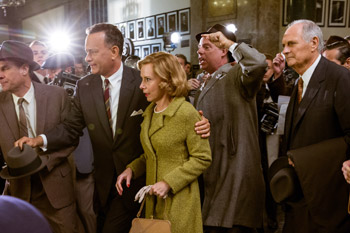 Before filming began, the actress had the opportunity to meet Mary's granddaughter. 'I saw her family's wedding albums and vacation photos and heard firsthand stories where I found out that Mary was born in Bay Ridge, raised in a strong Irish Catholic family, graduated from Marymount College and eventually settled down in Park Slope," Amy Ryan explains. 'Mary was proud of what her husband was doing, but she didn't like the attention it drew to her family and worried that their children might be in danger."
Before filming began, the actress had the opportunity to meet Mary's granddaughter. 'I saw her family's wedding albums and vacation photos and heard firsthand stories where I found out that Mary was born in Bay Ridge, raised in a strong Irish Catholic family, graduated from Marymount College and eventually settled down in Park Slope," Amy Ryan explains. 'Mary was proud of what her husband was doing, but she didn't like the attention it drew to her family and worried that their children might be in danger." Amy Ryan's biggest challenge was making her character, a woman in the midst of extremely-trying circumstances, believable. Says Platt, 'Amy Ryan's portrayal of Mary has us rooting for her, but we also feel her conflict over wanting to protect her family. Her husband's involvement with the case brings the family some danger and causes friends to sort of drop away, and you feel the tug-of-war within her to want to protect and love her husband and do what he thinks is right, and yet to protect her family at the same time, and you love her for that conflict."
Amy Ryan was especially thrilled to have the opportunity to work with Hanks, finding him generous, both in spirit and energy. 'I was very impressed with the amount of enthusiasm he was able to bring to each scene, and he's had so much experience as an actor that I tried to listen and observe as much as I could," she says. 'In addition to all the technical sides of knowing where the camera is going to be and where the lights are, he is still able to inhabit the scene so fully and truthfully…that is an amazing skill."
And for Tom Hanks, the feeling was mutual. 'Working with Amy Ryan was amazing…I was always thinking that it looked as if she was hardly doing anything, and yet she was doing everything all at the same time."
With the story's protagonists in place, the filmmakers set out to cast the supporting roles integral to Donovan's story, consulting with New York-based casting director Ellen Lewis. SaySteven Spielbergs , 'There have been many times when I wanted to use Ellen but she was working with Scorsese, and this was an opportunity where Marty wasn't working and Ellen was available, which was great because I wanted to use predominantly stage actors."
Theater actor Scott Shepherd, who received Obie Awards for his performances in 'Gatz" and 'Poor Theater" and has appeared on-screen in 'Side Effects," was cast as Hoffman, the shrewd CIA operations officer. The CIA was looking for a private citizen like Donovan to negotiate the swap in East Berlin so it wouldn't be governments talking, and it is Hoffman who secures Donovan's participation in the dangerous mission. But the two men soon go head-to-head as Shepherd expects Donovan to value national security over attorney-client privilege.
When Donovan accepts the assignment, Hoffman stresses that he will be on his own. Neither the U.S. nor the Soviet government can have any involvement in the operation…the German Democratic Republic will broker the exchange directly with him. Adds Tom Hanks, 'Donovan had given a vociferous, authentic and passion-filled defense for this Soviet spy who was arrested, which was then tabbed by the other side to help facilitate an exchange that would get one spy back to the Soviet Union and another one back to the U.S."
Donovan believes that Abel was acting honorably, but when he comes across some technicalities in the search and seizure of Abel's art studio and apartment, begins to question whether Abel received due process at the time of his arrest. Platt explains, 'This is basically a guy from the CIA who believes that the most important thing should always be protecting the security of the country, and Donovan has a different set of principles that have to do more with his take on the Constitution…sort of a Constitutional viewpoint versus a national security viewpoint."
With credits including the landmark television series 'M*A*S*H" and the film 'The Aviator," among numerous others, Alan Alda took on the role of Thomas Watters, a senior partner at the law firm of Watters, Cowan & Donovan. 'My character sort of edges Donovan out of his job in order to protect the firm," says Alda. 'Watters just wants to protect the firm and prevent Donovan from becoming too idealistic, which was a clever way for the screenwriters to show what Donovan was up against when he agreed to take the case."
Up-and-coming young American actor Austin Stowell, who was most recently seen in the highly-acclaimed 'Whiplash," is Francis Gary Powers, the young Air Force pilot who joins the CIA to fly covert missions in a U-2 spy plane and is subsequently shot down over the Soviet Union. There, he is imprisoned and subjected to solitary confinement and sleep deprivation, eventually suffering the humiliation of a very public Moscow show trial. Spielberg recommended the actor after watching his dailies from 'Public Morals," a period cop TV drama executive produced by Spielberg, in which Stowell has a starring role.
During the Cold War, the need to gather strategic military information from our adversaries led to the development of the U-2 spy plane by the U.S. A reconnaissance aircraft that flew at heights of 70,000 feet, twice the altitude of a commercial jet, the aircraft was undetectable by Soviet radar. Powers passed away in 1977, but his son, Francis Gary Powers, Jr., has a cameo in the film as a CIA agent involved with the training of the U-2 pilots, or 'drivers" as they were commonly referred to at the time.
German actor Sebastian Koch, who starred in the Oscar®-winning film 'The Lives of Others" and the action-thriller 'A Good Day to Die Hard," was cast as the petulant, devious East German 'lawyer" Wolfgang Vogel, who represents Abel's so-called family, and with whom Donovan must discuss Abel's exchange. Vogel works for the Communist government of the German Democratic Republic (GDR), which was not recognized by the U.S. government but was desperately trying to become its own country.
Steven Spielberg explains, 'Nationalist East Germany was actually shaking their fists at the Soviets, saying, -I know you feed and clothe us, and provide for us, but we are not your puppets." Donovan ends up trading Abel to two different parties: Vogel and the GDR for Frederic Pryor at Checkpoint Charlie and Ivan Schischkin and the Soviets for Powers at Glienicke Bridge. Russian actor Mikhail Gorevoy, best known to audiences as the Bond villain Vladimir Popov in 'Die Another Day," signed on as the enigmatic Ivan Schischkin, a Soviet official who calls himself an assistant secretary in the Soviet East Embassy in East Berlin but who is, in fact, a high-level KGB operative with whom Donovan must negotiate. The young American actor Will Rogers, who has appeared on-screen in 'A Good Marriage," came on board as Frederic Pryor, an American student arrested in East Berlin, whom Donovan learns about while he is in East Berlin to negotiate Powers' release and insists must also be part of the exchange.
There are only a few routes left in the east… the rule of law is less firmly established over there. Just avoid interaction with people generally…you don't belong. - Hoffman
Re-Creating The Cold War On-Screen
The Landscapes: New York, Germany and Poland
While the cast and crew were being assembled, the filmmakers were simultaneously deciding where to shoot the film, hoping to use many of the very places where the events in the story actually took place. After scouting locations in the U.S. and Europe, they settled on New York City; Berlin, Germany; and Wroclaw, Poland.
Structurally the story is a study in shifting moods and environments, opening in Brooklyn in 1957 with the action eventually moving to East Berlin. Because of this, the production utilized two different crews for principal photography: one crew to film scenes in and around New York and a different crew in Germany and Poland, each with its own pre-production schedule and each tasked with effectively creating their own cinematic universe that needed to remain faithful to period details.
Producer Marc Platt explains, 'Producing this film was interesting because it was almost like we were making two separate films, which is representative of the extraordinary journey that James Donovan goes on. We first meet him in Brooklyn where he takes on the case, which was one movie, and then he travels unexpectedly to a completely different part of the world, a completely different culture, which felt like an entirely different film."
Adds producer Kristie Macosko Krieger, 'It was pretty complex. We knew we wanted the audience to go on a journey, and we shot, for the most part, in continuity. Because of time constraints we had a few scheduling issues with some of the crew we normally work with, which allowed us to discover some amazing people that we had never used before. We had Adam Stockhausen, who is a brilliant production designer; Kasia Walicka Maimone, our costume designer; and the composer Thomas Newman, and those three really helped infuse the film with vitality."
'There was not a single day when we didn't show up on the set for the first time and think, Holy cow, this is not just an odd little re-creation…this is a three-dimensional, authentic, holographic representation of what it was," says Tom Hanks.
Principal photography on 'Bridge of Spies" kicked off in September 2014 in Manhattan, and over the next month the production made the most of the city's diverse architectural styles and its geographically-adjacent boroughs. Cameras manned by cinematographer Janusz Kaminski first rolled in lower Manhattan at Wall Street, filming exteriors of Donovan on the steps of the Federal Courthouse at Foley Square.
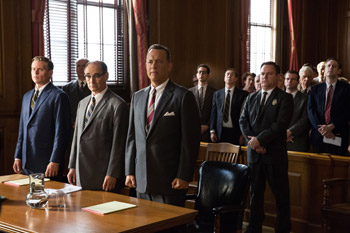 Kaminski's first film with Spielberg was 'Schindler's List" in 1993, and since that time they have worked on more than a dozen films together. According to Platt, 'One can start a sentence and the other can finish it, and the result for us as moviegoers is to watch the film come to life and to watch the beauty of it, the look and the feel of it, and that lies in whatever miraculously occurs between Janusz and Steven Spielberg."
Kaminski's first film with Spielberg was 'Schindler's List" in 1993, and since that time they have worked on more than a dozen films together. According to Platt, 'One can start a sentence and the other can finish it, and the result for us as moviegoers is to watch the film come to life and to watch the beauty of it, the look and the feel of it, and that lies in whatever miraculously occurs between Janusz and Steven Spielberg." Renowned for his ability to capture emotional details amid stunning visuals, Kaminski's primary goal is establishing a cinematic grammar in which to tell the story. Fortunately with 'Bridge of Spies," the outstanding locations, set dressing and costumes provided countless opportunities for the camera.
'What I love about working with Janusz is that I can understand very quickly the stakes that he's going for," says Tom Hanks. 'I can ask him what will be in the shot and he will tell me, so I have the luxury of working with someone like that who will help me, which means a couple of things: I will not screw up the shot, and he will help me get another little moment of James Donovan into a scene."
Manhattan's Metro station at Broad Street was the setting for scenes of Rudolf Abel being tailed by the FBI and of Donovan on his way to work, as the producers felt that a live subway system was needed to realistically film a subway car from a station platform. Fortunately New York's Metropolitan Transportation Authority was eager to work with the production, allowing access to the subway station very early on a Sunday morning.
The film's production designer, Adam Stockhausen, a recent Oscar® winner for 'The Grand Budapest Hotel," explains, 'We had to work fast in -blitz-style,' which meant swapping out posters and signage, changing lighting fixtures and redressing everything from top to bottom. And then, of course, everything had to be put back in place as quickly as possible." Interior subway shots were filmed in actual subway cars from the 1960s housed at the New York City Transit Museum.
In midtown Manhattan, the offices of the New York Bar Association, located in a classical historical landmark at 44th Street, provided the ideal setting for Donovan's law firm, instilling a sense of old-world money and prestige. Multiple shoots in Brooklyn followed, on locations in Flatbush and Brooklyn Heights, as the borough still features a number of period buildings. It was in Ditmas Park, a residential area made up of quaint homes situated on peaceful, tree-lined streets, that Stockhausen found the ideal location for the Donovans' home: a beautiful, freestanding Victorian home full of charm and period detail with a front porch and small backyard, which helped convey Donovan's strong connection to his neighborhood.
Interiors of the Donovan home and additional set pieces were built on soundstages at Brooklyn's Steiner Studios. Says Macosko Krieger, 'When I stepped onto the set of Donovan's home for the very first time it was like I had gone back in time to the late -50s and I was having dinner with someone's family. Adam Stockhausen got every little detail perfect in that house."
A strong sense of history infused the production once filming began in Europe, as the iconic locations helped depict, in stark images, the horrors to which the East Germans were subjected, instilling a sense of respect for what these people had lived through.
Flughafen Tempelhof Airport in the south-central section of Berlin, where the historic airlifts of 1948 and 1949 took place, was an indispensable location. These airlifts took place when the Soviet Army closed off access to the western part of the city by all other means of transport. Planes from the U.S., Great Britain, Canada, Australia, New Zealand and South Africa transported food and supplies to the city's inhabitants to prevent them from starving. Spielberg filmed multiple scenes at Tempelhof, including Donovan and Powers' return home to the U.S. inside a U.S. Army cargo transport plane. Scenes featuring actual U-2 planes, both on the ground and in the air, were shot several months later at Beale Air Force Base in Yuba County, California.
The crash of Powers' U-2 spy plane was shot via a large screen at Tempelhof, where Stockhausen and his team built a replica of the U-2's cockpit on a motion base which was used for all the close-ups of Powers in his aircraft. According to Macosko Krieger, 'It was amazing to be able to shoot with these old airplanes at beautiful locations like Tempelhof where the events in the story actually took place…you can't re-create stuff like that."
Berlin's historic Glienicke Bridge, where the actual exchange of Abel for Powers took place, was the setting of the story's historic climax. The Bridge spans the Havel River and is near Wannsee, where the Wannsee Conference with Adolf Eichmann and the other architects of the Holocaust took place. During the war, the Bridge separated East and West Berlin…today it connects the Brandenburg section of Berlin to the suburb of Potsdam.
Scenes of Donovan trying to talk his way past East German guards at the Friedrichstrasse Checkpoint so as to not miss his appointment at the Soviet Embassy with Wolfgang Vogel, were filmed at Berlin's City Center. Friedrichstrasse, which is more commonly referred to as Checkpoint Charlie, is the best-known border crossing between East and West Berlin. 'Everyone assumes the only way into East Berlin was through Checkpoint Charlie, but that wasn't the case," Stockhausen points out. 'You could actually take the S-Bahn past the border and get off at the Friedrichstrasse Station, but when you got off you'd still have to go through a checkpoint to enter the East."
Finding a place to shoot the scene in contemporary Berlin had initially presented a challenge for the filmmakers, as the Friedrichstrasse Station standing today is more modern than the one that existed during the Cold War. But Stockhausen came up with a solution and re-created the station using a hulking, rusty overpass of S-Bahn tracks near another S-Bahn station that ran along a crumbling brick wall.
To film crucial scenes in the story which took place at the Berlin Wall, the production moved to the city of Wroclaw in Poland, approximately four hours southeast of Berlin. Wroclaw (pronounced Vrohkluff) was in a state of disrepair, the result of economic hardship and years of neglect, but similar in look to that of a city ravaged by war. The city had actually been part of Germany before the borders were redrawn and was called Breslau at the time, so all the architecture was German in style. According to Platt, 'Many of the buildings had not been touched since the war….there were literally bullet holes in some of the buildings."
The Berlin Wall was in the midst of construction when Donovan's story took place, and Spielberg wanted the audience to see it being built on-screen as well. The first version that went up was a makeshift wall made from concrete blocks and barbed wire, which was quickly replaced with the version most recognise today with reinforced cement slabs and an enormous pipe on top, making it much more sturdy and more difficult to scale.
Stockhausen and his department built approximately 300 yards of the Wall at different phases of its construction with the same materials and same dimensions as the original. It is when the American student Frederic Pryor comes into the story that the audience first sees the Berlin Wall. Pryor, while visiting a professor in East Berlin (whose daughter also happens to be his girlfriend), has an unfortunate encounter with the East German border guards, who arrest him as he tries to return to the West. Donovan first hears about Pryor when he is in East Berlin, and refuses to leave the country unless Pryor is factored into the exchange of Powers for Abel.
The end result on-screen conveys not only the terror of the Berlin Wall, but the confusion as well. Says Steven Spielberg, 'The Berlin Wall was really symbolic, but it didn't look like San Quentin or Alcatraz or some other huge federal penitentiary. The walls were actually fairly easy to scale, you just didn't dare do it. When we shot those scenes I looked at the Wall and thought to myself, -Did this really happen? Was Berlin really divided like this?' It brought back a time in my life when walls started to go up all over the world, most of them invisible walls, but walls nonetheless."
'It was terrifying, and it felt so permanent, too," adds Tom Hanks. 'What production designer Adam Stockhausen was able to do with the Wall, finding that perfect crossroads in the city of Breslau in Poland that matched up so well to the architecture of the time, was truly amazing."
Production in Berlin coincided with the 25th anniversary of the fall of the Berlin Wall. Even though the city of Berlin was located entirely within the Soviet portion of Germany, East Berlin was part of the Soviet Union; West Berlin was not. Residents of the city were able to go back and forth until the GDR built the Berlin Wall to separate the two cities, and entrance was only accessible at one of several check points located along the Wall.
On November 9, 2014, thousands of people gathered in Potsdamer Platz to commemorate the date when the East German government rescinded travel restrictions between East and West Germany. For the cast and crew filming the following day on the set of the Friedrichstrasse Station created by Stockhausen's team, it was a vivid reminder of the conditions of violence, surveillance and deprivation under which the East Germans lived.
Portions of Friedrichstrasse Checkpoint were re-created in Wroclaw by Stockhausen and his team as well, including its iconic sign which reads: You Are Now Leaving the American Sector in three languages. The set was used to film the climatic sequence where Frederic Pryor is being escorted to the Checkpoint by Vogel, among others. 'Everything about the Checkpoint Charlie set was remarkable," says Platt. 'You felt as though you were living in that moment in time, in history."
'These people do work that I can't even begin to fathom," adds Hanks. 'It all just looks like homework to me, and they always seem to be just barely operating in time to get it all done. But when you see the end result and it is so evocative that even someone like myself who knows that it is a set still lingers on it as long as possible, that is a special talent."
Mark Rylance agrees, saying, 'The sets were all incredibly beautiful with an amazing amount of detail. As an actor, we are working among craftspeople, and just being surrounded by these people with such skill and love for what they do is very inspiring. It is the combination of all these crafts which make a great film, and Steven leads so creatively."
Fashioning the Colors and Textures of the Period
On 'Bridge of Spies," costume designer Kasia Walicka Maimone, whose film credits include 'Foxcatcher" and 'Moonrise Kingdom," was responsible for effectively conveying the time period of the story through the visual design of the clothing and accessories, but her biggest challenge on any film is to be a good listener. She explains, 'With each project we have to come up with new ways to understand what the story is telling us, to really grasp the color of the period and represent it in a subtle way that helps to portray the story and not overpower it."
Walicka Maimone's research showed that, for the most part, people dressed up in the late -50s and -60s. 'Men and women were more formally-attired, meaning suits and hats for men and dresses, suits and skirts for women," she says. 'But the men's suits were not at all like those worn today. They were constructed in another manner, an older tradition, with a different body shape, a different sleeve, a different fit to the trousers and a thicker weave in the fabric."
'Bridge of Spies" was her first film with Steven Spielberg, and she was thrilled to find they spoke the same language and shared a similar visual understanding of the story. Working closely with production designer Adam Stockhausen, she immersed herself in the worlds in which the characters existed, hoping to find a glimpse into the truth about them. Fortunately, she had a great deal of freedom when creating the looks which would define each character, because they weren't playing iconic people anyone would actually recognize.
For the character of Mary Donovan, played by Amy Ryan, Walicka Maimone drew inspiration from Jackie Kennedy and accentuated Ryan's look with a string of pearls and glasses similar to ones worn by James Donovan's wife. 'We had a lot of good information about the real Mary Donovan, most of which came from Amy, including some amazing photographs from the family's personal collection," Walicka Maimone says. 'Looking at those photos helped us understand the essence of who this woman was. We created a lot of pieces for her, like the green coat she wears in the courtroom, which seemed to represent the era and, subliminally, provide the audience with a better feeling of that time."
Amy Ryan says, 'She created these beautiful looks for the time period, and even though my costumes were more casual in style, each was more beautiful than the next. But the undergarments were far more constricting than what I'm used to wearing, which, believe it or not, helped me get into character since I had to move differently."
The wardrobe reflected the culture and the period of the story, helping to articulate the director's vision. 'The costumes were off the scale, which is really saying something," says Tom Hanks. 'Anyone can go to a costume house and rent a bunch of stuff, but they still end up looking like rental costumes. I don't know how she did it, but Kasia was always coming up with fresh ideas, everything down to the waitress uniforms in Berlin's Hilton Hotel…but that's what artists do."
When shooting exteriors, the period costumes worn by extras helped reinforce the sense that these scenes, despite a vibrant immediacy in the present, were happening in the somewhat distant, yet recognizable, past. Some scenes featured over 300 extras, everything from spectators and reporters in court to subway passengers and pedestrians on the streets, and on cold days, required dressing them not only in clothing, but with appropriate accessories like hats, scarves, gloves and overcoats as well.
'Our job was to deliver a sense of reality in those scenes," Walicka Maimone says. 'We discussed every single extra that needed to be dressed because in order to represent a crowd effectively, you need to have a good mix of people. When having to present a crowd which represents the humanity and the streets of New York, the collaboration starts with the extras casting director, because it's much easier to dress people when they have great faces."
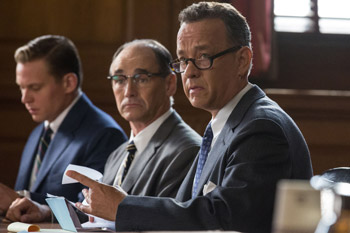 Equally key was ensuring all the wardrobe colors were authentic for the specific time period. Scenes set in New York featured clothing that was much more color-driven, representing the successful, commercial world of America in the -50s, with women wearing predominantly green, maroon and yellow, and men, brown, gray and navy. In Berlin, colors were scarce and muted when used, as most everything was black and/or dull gray to reflect the city's dismal atmosphere at the time.
Equally key was ensuring all the wardrobe colors were authentic for the specific time period. Scenes set in New York featured clothing that was much more color-driven, representing the successful, commercial world of America in the -50s, with women wearing predominantly green, maroon and yellow, and men, brown, gray and navy. In Berlin, colors were scarce and muted when used, as most everything was black and/or dull gray to reflect the city's dismal atmosphere at the time. 'We needed to effectively represent the period and the colors of the period, so Adam and I mapped out the balance of colors to figure out how everything was going to match," Walicka Maimone says. 'We absorb as much of the vocabulary from that time period as we can, choose whatever is needed for the particular frame of the film, and then construct those realities so they are strong enough to resonate the period, while not overwhelming the story."
Evoking the Mood and Emotions of the Story
Thomas Newman, a member of the legendary Newman film-scoring family (which includes father Alfred, brother David, uncles Lionel and Emil, and cousin Randy), was brought on board to create music that would complement James Donovan's powerful story without overpowering it. In the words of Tom Hanks, 'Great scores do two things: They play underneath and you don't even notice them, or they play and you can't imagine the scenes without them."
The composer, whose credits include 'Cinderella Man," 'Jarhead" and 'Little Children," says, 'This is an American story"the difficulty was figuring out the best way to represent America in a way that didn't sugarcoat anything, while representing the ideals of Donovan at the same time. What it ended up boiling down to, for me, was simple family values, a sense of what it means to be an American in the most idealized sense of the word."
DreamWorks had worked with Newman on numerous films over the years, including such acclaimed titles as 'The Help," 'The Road to Perdition" and 'American Beauty," but 'Bridge of Spies" was the composer's first time writing music for a film actually directed by Steven Spielberg. 'Steven was a true collaborator," says Newman. 'You can sense someone who very much understands the notion of artistic collaboration and wants to bring things out of the people that work for him, and that is definitely Steven."
Music has always played a crucial role in Spielberg's films, but from day one he envisioned 'Bridge of Spies" differently. There are approximately 38 minutes of music in 'Saving Private Ryan" and about 38 to 40 minutes of music in 'Bridge of Spies," and there is no music in this film for the first 20 minutes. Spielberg explains, 'Many of my films are dependent on score, sometimes even dependent on wall-to-wall scoring, but I didn't feel -Bridge of Spies' was that way, the same way I didn't feel that -Private Ryan' needed wall-to-wall music."
'It's pretty compelling," says Newman. 'The sounds of New York City really set up a sense of anticipation about what was going to happen to Abel. Francis Gary Powers' plane crash is also brilliantly done without music, and it's just thrilling that it's all sound."
When Newman's score does kick in, the music is understated and brilliant in its simplicity. As Donovan becomes more involved with the CIA, the score escalates from simple piano to full orchestration, a subtle difference, but one which Spielberg believed would add some emotional weight to the friendship between Abel and Donovan. The score was performed by an orchestra made up of 85 musicians and was occasionally supplemented by vocals from a male choir, but Newman was cautious that it did not imply any kind of political bias. He explains, 'In terms of that color, I didn't want the music to say, -Okay, here is Russia and here is America, and Russia is going to be represented by deep male voices,' but I did want to kind of push that as a means of compelling the story."
Steven Spielberg was clear with Newman that he was not expecting him to deliver a John Williams score. 'Steven has a very fundamental, almost primal, relationship with John Williams, and a very successful one at that, but he encouraged me to write music that reflected my aesthetic as opposed to trying to match John's," says Newman. 'I've known John forever through my family, but I always knew I didn't want to end up being a third-rate John Williams because his style has been such a defining part of what movie music is."
Adds Steven Spielberg, 'It was devastating to me because John was having this medical thing, and he's okay now, thank God, but we have always worked together, and after 42 years of collaboration, not to work with him was almost incomprehensible. At one point my response was not to have any music at all…it would just come out of record players and radios and those kinds of things. But then I knew that there were parts of this film that really would benefit from score and I didn't think twice when I knew it wasn't going to be John…the first person I thought of was Tom Newman."
'When Steven Spielberg and I would get together to discuss the music, he was always looking at the movie as someone who was trying to enjoy it and trying to relate to it as opposed to someone who had intentions," says Newman. 'So he would watch and listen and he would react, which was ultimately very rewarding because I felt like I found my own voice and that the voice was accepted by Steven Spielberg."
While John Williams was unavailable to score the film due to a minor health issue, which has now been corrected, he will write the score for Spielberg's next film, 'The BFG."
Seamlessly Weaving the Elements Together
Molding a film about the courageous exploits of a family man turned Cold War spy negotiator presented editor Michael Kahn with a unique challenge. 'It was a big dialogue piece," explains Michael Kahn. 'He shot it in more of a conventional way, where dialogue was key. He wanted the audience to really be involved in what was being said and to really think about things, so we didn't cut it like an action film. In fact, Tom Hanks and Mark Rylance's performances were so scintillating at some points that it was difficult to cut away at all."
It was important for Steven Spielberg that James Donovan remained the story's focus, and the fact that there was no music at the beginning of the film helped to reinforce the story and accentuate the dialogue. Kahn explains, 'By not having music there, it allowed us to really get a sense for what Donovan's life is like, and it worked out beautifully because we got to know him quickly because we were able to hear all the dialogue so clearly."
Michael Kahn is one of Steven Spielberg's longtime collaborators, a relationship that dates back to 1977 and 'Close Encounters of the Third Kind." According to Hanks, 'Matt Charman realized that there was something fantastic there and wrote it up, and then the Coens end up sprinkling their substantial amount of fairy dust on it. Some of those are in the text, but the timing and the composition is all Steven Spielberg and Michael Kahn. Thank God they have the shorthand that they do, because no one can write that stuff."
On 'Bridge of Spies," Steven Spielberg would run the dailies with Michael Kahn and his team and give them his scene selects. And because the director prefers to edit during principal photography, coming in before call time, during lunch and after wrap, Michael Kahn was able to assemble a cut of the film relatively quickly. 'It's great to be able to show him things while he's on the set and to get his feedback while we're cutting," says Michael Kahn.
Another challenge for Kahn was determining the best way to effectively combine multiple stories involving four different characters"James Donovan, Francis Gary Powers, Rudolf Abel and Frederic Pryor"and showing how they were all connected, even though they were all quite different. 'That's part of the magic of Michael Kahn and Steven Spielberg's collaboration…that they are able to put those things together so that they feel seamless when you see it finished," says producer Kristie Macosko Krieger.
Behind The Scenes With The Director
Steven Spielberg's intuition of how to combine the camera and visual storytelling with text and subtext and character is prodigious. 'Every director is a visual storyteller, but what sets Steven Spielberg apart is that he is literally taking in everything that's going on around him," says producer Kristie Macosko Krieger. 'He allows every other department to be at their best at all times because he trusts them, so there is a sense of calmness on the set because every person on the crew has the confidence to do what they do so well."
For Janusz Kaminski, who hoped to visually convey the reality of the Cold War on-screen, the cinematographer needed to come up with creative ways to revive the period while not going overboard, as he knew that too much imagery would look fake. Steven Spielberg explains, 'We didn't have the budget to put blue screen and show miles and miles of digital period buildings out the window, so we had the windows frosted over. Then Janusz brought all the light, one source, a single source, from the glass, and it gave that first meeting between Donovan and Abel a real coldness. As a warmth began to develop, or at least the opportunity for a relationship began to occur to us (and to them), you could interpret that cool light as being sort of a wall between them that would slowly come down over the course of their story."
'Watching Janusz work is phenomenal," says Macosko Krieger. 'He sees things that none of us can see, and he sees it in the light and he sees it where the camera is and it just seems so instinctual to him."
As producers, Macosko Krieger and Marc Platt's contributions were quite substantial. Tom Hanks explains, 'Kristie knows everything in and out, back and forth. She knows the script better than I do and she knows the subtext of every discussion she's ever had with Steven Spielberg. Kristie realises we've got 82 billion working parts, and she can break down every one of those. No matter what is going on with Kristie at that exact moment, you can come up to her and have a fully-realized conversation about the topic at hand. She can tell you exactly what the status is of anything."
'Marc knows the place that the movie holds in the Zeitgeist of films," Tom Hanks says. 'He takes into account the history, the period and the casting choices and views it as a single-celled creature. A lot of times producers are beholden to the director because without the director their film doesn't get made. But I think Steven Spielberg is beholden to Kristie and Marc because, without them, he doesn't have the freedom to think about the work purely in cinematic terms."
'Steven Spielberg is a very fatherly figure," says Mark Rylance. 'I didn't realise how important and how much time he puts into his family until we worked together. I don't know how he finds the time with all the things he's doing, but he's really quite a family man and has maintained that, which is quite extraordinary for such a busy person."
According to Steven Spielberg, some of the best moments in his films are accidents, either accidents of interpretation or something audiences read into on their own. 'Other times they are determined choices for which I cross my fingers that people will discover as they watch the movie," he says. 'And that's the most satisfying thing: when you intend something and people understand what your intention was, and they're getting it and they're liking what they're getting. That's the best reward."
One incident in particular which stood out for the cast involved the inadvertent smashing on the ground of used flashbulbs from the press photographers. It was after the reading of Abel's verdict in court when the media were surging around Donovan, his wife Mary and Thomas Watters. Rylance explains, 'Steven Spielberg came up with the idea of using these discarded bulbs littering the floor as a way to heighten the drama when Mary, who's being overwhelmed by the media, steps back and her high heel crunches one of the bulbs."
Amy Ryan adds, 'Steven Spielberg had this idea in an instant. I saw him get down onto the floor at the level of the camera so he could see exactly what the shot, the smashing of the bulbs, would look like. We learn a great deal about Mary because of the way Steven filmed this scene, myself included."
'It ends up making a comment on the waste," says Tom Hanks. 'It wasn't even in the script, it wasn't even a cool shot, but it actually added to the tapestry of the moment, and Steven Spielberg comes up with stuff like that because that's the way he thinks."
'Steven Spielberg thinks in cinematic terms," says Tom Hanks. 'His ability to tell important story moments just by what he does with the camera is the reason he's Steven Spielberg. He's done it again and again and again, and all you can do is stand back and watch."
In addition to being an amazingly-proficient filmmaker, Steven Spielberg is genuinely concerned about his actors and has a profound respect for their craft, constantly looking for ways to create a story on-screen in the easiest and most natural way possible. Tom Hanks says, 'Steven Spielberg and I have a pretty good shorthand. I would come in with an enthusiastic idea for how to go about the scene and Steven Spielberg would say, -That's great, because what I want to do is play it all the way from back here, and if you're moving around like that, that's where the eye is going to go.'"
Rylance was amazed by the amount of preparation involved with each setup on 'Bridge of Spies," comparing it with a Renaissance workshop. 'Steven comes in and you see him take in everything all around him," he says. 'He is in total command of the big picture and everything going through the frame, the sets, the background actors, all the movements. Watching him, I imagined Leonardo da Vinci at work. He was like a painter, but working with moving pictures." Adds Hanks, 'When you show up on Steven's set, it has already been built, not only physically, but deep inside Steven's head. Your job is to do exactly what he wants you to do, but he also expects you to add in all the little things he expects you to come up with. He has the film cut in his head long before we even get to the set. He reads the screenplay thousands and thousands of times, over and over and over again, so he knows what he's going to be doing, cinematically, five weeks from now."
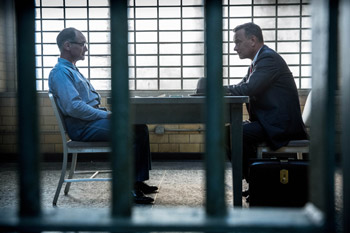 'Bridge of Spies" was a tremendous learning experience for Ryan. 'Steven Spielberg is so enthusiastic about what he's doing that it's infectious," she says. 'There were times when I would be observing him at work and all of a sudden his eyes would get big as saucers, almost as if he was this 12-year-old boy still making films in his backyard."
'Bridge of Spies" was a tremendous learning experience for Ryan. 'Steven Spielberg is so enthusiastic about what he's doing that it's infectious," she says. 'There were times when I would be observing him at work and all of a sudden his eyes would get big as saucers, almost as if he was this 12-year-old boy still making films in his backyard." Steven Spielberg also puts a tremendous amount of focus on the narrative. While some directors are focused on the feelings of the actors or the beauty of the images, he's more concerned about where the audience's imagination is. Macosko Krieger says, 'What's great about Steven Spielberg is that he truly loves being on set. In the mornings when we get to work I'll say, -Is there anything else you'd rather be doing in the world right now?' and he says, -No,' and it's true. He knows he is incredibly lucky to do what he does."
Shouldn't we show our enemies who we are? -James Donovan
An Ordinary Man Placed In Extraordinary Circumstances
Sometimes truth is stranger than fiction, and with 'Bridge of Spies," the incredible story of an ordinary man placed in extraordinary circumstances, it is all the more compelling because the character at the heart of the story is a real person.
Because of his association with Rudolf Abel, James Donovan was subjected to a great deal of scrutiny from the media and the general public, and a source of fascination in the story for Steven Spielberg is the notion that people often jump to conclusions and make snap judgments, which ended up helping him determine the best way to approach the story. He explains, 'We have to find the villain and find the hero in real-life stories, and so by quickly targeting and earmarking a villain, we immediately stop being mindful, or even empathetic, about the person that we deem a villain. We give all our empathy to the hero, and we give no credit and no currency to the villain. By doing that, we become very one-sided and all our tolerance goes out the window."
Steven Spielberg continues, 'One of the things I loved about this story was that everyone you think should be wearing a black hat isn't necessarily wearing that hat, nor did they intend to. It doesn't make it easy to root for someone who is a spy against the national security of our nation…how could we possibly come out on the other end of this experience caring about this person in the least? But in this case we do, and that was something that made me want to get involved with the project."
In the story, people judge Rudolf Abel for who they think he is and what they think he is doing, but James Donovan sees something different in him. And Francis Gary Powers is being judged as someone who let himself fall into enemy hands, yet Donovan sees him as a pilot who did his best, who didn't give any secrets away but who held the line.
'There is this wonderful moment at the end of the film when people on the subway who had misjudged Donovan earlier are looking at him anew because they realize what he's accomplished and that they were wrong to judge this guy and this situation," says producer Kristie Macosko Krieger. 'It's a fantastic moment for his character."
Navigating the unfamiliar waters of high-stakes international intrigue, James Donovan rose to the occasion with a modesty befitting the heroic acts that he performs, becoming an unsung civilian hero, and, in the process, the inspiration for an incredibly powerful story and film.
Bridge of Spies
Release Date: October 22nd, 2015
Have You Seen This?
MORE
- Mission: Impossible Fallout
- Glenn Close The Wife
- Allison Chhorn Stanley's Mouth Interview
- Benicio Del Toro Sicario: Day of the Soldado
- Dame Judi Dench Tea With The Dames
- Sandra Bullock Ocean's 8
- Chris Pratt Jurassic World: Fallen Kingdom
- Claudia Sangiorgi Dalimore and Michelle Grace...
- Rachel McAdams Disobedience Interview
- Sebastián Lelio and Alessandro Nivola...
- Perri Cummings Trench Interview

